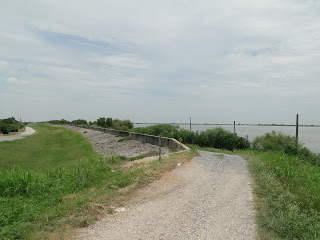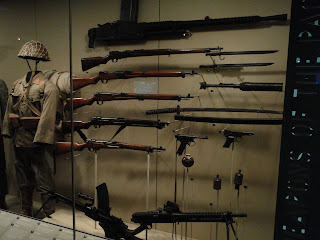New Orleans area
Crossed into Louisiana
Over Lake Pontchartrain. The original bridge was wiped out by Hurricane Katrina, This is the new one.

Through New Orleans to Belle Chasse.

One of the reasons we came here was the Mississippi River. We wanted to see the end of it.
Last year we went to the start of the Mississippi River
and waded across the very start of it.

Not really impressive about a mile from Lake Itasca.
or as it flows into the first town, Bemidji, MN,
We have seen it as it flowed through such cities as Minneapolis, St Louis Memphis New Orleans, etc. It travels through or borders 10 states and a lot of major rivers dump into it.

It is over a mile across in several places of the lower Mississippi.
Note the ship on the center right.

Ten foot levees such as this are along most of the lower part to prevent flooding during winter thaws.

Venice, LA, almost to the end, the last city on the Mississippi.

from here it flows into the Gulf of Mexico

I went to army boot camp in Ft. Jackson, SC. I did not know that there was another Ft.Jackson.
Fort Jackson, LA is an historic masonry fort located some 70 miles south of New Orleans on the western bank of the Mississippi after the War of 1812 on the advice of Andrew Jackson, for whom it is named.

Fort Jackson was the site of the Battle of Forts Jackson and St. Philip from April 16 to April 28, 1862, during the American Civil War. The Confederate-controlled fort was besieged for 12 days by the fleet of U.S. Navy Flag Officer David Farragut. Fort Jackson fell on April 28 after the Union fleet bombarded it and then sailed past its guns.
Union forces then went on to capture New Orleans.
It was damaged badly by hurricanes Katrina and Rita.
Gun emplacements

Cathy and Freddy wandering around
We did have a picnic lunch of wine, cheese, crackers and corn chips with us.
The picnic area was not rebuilt after the hurricanes and also was muddy. So, we parked under the trees,

and next to a lake.
Freddy says "where is mine?"

Shipping past the fort.

We are staying at an RV park on NAS New Orleans. It is across the river from N.O. and to get to any place in the city, we either have to drive across or take a ferry.
This day we decided to drive because where we wanted to go has a parking lot.
New Orleans sky line. Note the Super Dome center left.
Our destination. Gary Sinese has done several visits here with WWII veterans. Tom Hanks produced and stared in a movie they show here about WWII.

Just going in is impressive
a good sampling of WWII equipment
We went into the Pacific Theater section first.
Most of it is set as if in the jungles of the different islands.
The machine gun emplacements were really impressive

Air cooled and water cooled machine guns
plus a lot more different types of weapons.
Maps showing how the US took all the islands back
on the beaches
home sick GIs erecting signs to home

Now the European Theater.
Hitler controlled territory in 1942.
weapons used in Europe
don't forget the artillery
jeeps
war correspondents.
an area on Ernie Pyle
He was in Europe and later the Pacific where he was killed on Okinawa.
and Bill Mauldin
Ernie was a civilian and Bill was a GI, both very interesting.

the Nordon bomb site made bombing much more accurate

a winter machine gun emplacement
An Opel automobile confiscated and converted into a German staff car
The other way to get to NO from our camp is by a 10 minute ferry ride, cost $1.00

The landing is at the edge of the French Quarter.
We have been here multiple times so we will not be walking the streets. Been there, done that, too hot to do it today.

So we decided to enlist Fiona. You have to do this in the morning or late afternoon. They have a cut off temperture and then head for the barn.

Most of the French Quarter's architecture was built during the late 18th century and the period of Spanish rule over the city, which is reflected in the architecture of the neighborhood. The Great New Orleans Fire (1788) and another great fire in 1794 destroyed most of the Quarter's old French colonial architecture, leaving the colony's new Spanish overlords to rebuild it according to more modern tastes.

Balconies are abundant.
Street work does go on but all repairs to street and building is highly regulated.
Saint Louis Cemetery is the name of three Roman Catholic cemeteries in New Orleans, Louisiana. All of these graves are above-ground vaults; most were constructed in the 18th and 19th centuries.
Cemetery 1 was opened in 1789 and is still in use today.
The custom of above-ground burial in New Orleans is a mixture of folklore and fact.
The vaults are in fact more due to French and Spanish tradition than they are to water table problems.
A recent interment took place here recently.
Once a body is placed in a crypt, by law, it must remain untouched for 1 year and 1 day.
After that time, if the crypt is needed, the remains will be placed in a bag and moved to the rear to make room.
This cemetery covers 1 square block but contains the remains of several thousand people.
These vaults were called "oven vaults" due to their shape and probably due to the the heat inside.

They are owned by the church but some can be purchased by familys. Some vaults are kept in reserve for rental in case a family vault is in use and the time frame has not passed. Then after 1 year and 1 day they are opened and the remains are moved to the family vault.

Nicolas Cage has his vault here
This one is for Andrew Jackson's artellery batalion
One large one belonged to a private club

One belonged to a french Contessa's family.
Marie Laveau, the famous voodoo queen is buried here
Her crypt

Back in the buggy
through the French Quarter
Past the Natchez Trace
back to the West Bank ferry terminal.
We did find a couple of good "mom and Pop" Cajun restaurants.
and time to fix some ribs and potato salad for the Fourth of July.
and a nice sunset for a good send off.
Next stop, Morgan City, Houma and Pierre Part. All part of the Swamp People gator hunting area.












































Comments